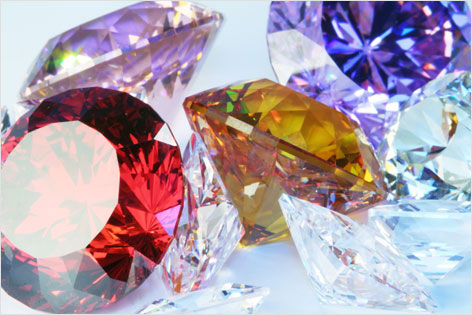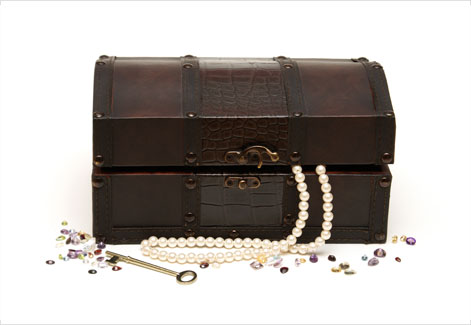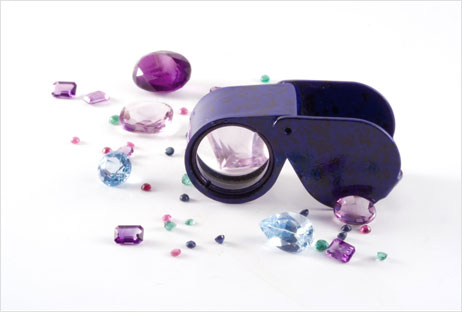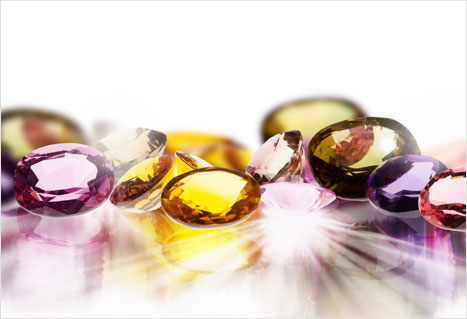Learn About Gemstones
Important Facts About Gemstones

A gemstone is a piece of mineral which is cut and polished to make jewelry or other accessories. However, certain rocks like lapis lazuli and organic materials like amber and jet that are not minerals are often considered to be gemstones and make exquisite pieces of jewelry. Most gemstones are extremely hard with a rigid crystaline structure. But some soft minerals are also used in jewelry for their lustre or other unique qualities that make them valued and valuable. The chemical composition of the gem determines most of its other properties like shape, strength, hardness and color. It may all sound quite arbitrary, but that doesn't take the shine off from a wonderful piece of jewelry with a beautiful gem as the focal point.
Characteristics
HARDNESS: Hardness is the gem's resistance to being scratched. This is how you can tell immediately what type of stone it is. The Mohs hardness scale was developed in the early 1800s by German mineralogist Frederich Mohs. From softest to hardest, here is his list:
- 1 - talc
- 2 - gypsum
- 3 - calcite
- 4 - fluorite
- 5 - apatite
- 6 - feldspar
- 7 - quartz
- 8 - topaz, emerald, aquamarine, some varieties of beryl
- 9 - corundum - (ruby, sapphire)
- 10 - diamond
Here are some other items you'll recognize and their Mohs scale hardness for comparison:
- 2.5-3 -- gold, silver
- 4-4.5 -- platinum
- 4-5 -- iron
- 5.5 -- glass
- 7+ -- hardened steel
STRUCTURE: Gemstomes come in two structures, crystalline and amorphous. The shape or morphology of the gemstone is important in identifying the gem and determining how it can be cut for presentation.
Crystalline structure: A crystal is a solid object with an orderly three dimensional arrangement of molecules repeated throughout the entire volume of the piece. Crystalline gems are single crystals. Rubies, emeralds, diamonds are crystalline gems. Since large single crystals are rare, size really does matter in the value of the stone.
Amorphous structure: This hard stone will contain a mixture of components and can include crystals, yet the stone itself is not a crystal. Jade and turquoise have amorphous structure. The jeweler carefully considers the components of each amorphous stone when deciding on how to bring out the best qualities of the stone through its cut.
EFFECT ON LIGHT: Refraction, absorption, diffusion, reflection, iridescence, fluorescence, opalescence, no matter what you call it, the way light plays through a gem is a real experience, like the gem expressing its thoughts or mood in that moment. These individual effects are properties gemologists use to identify and classify each stone. They are also important to the buyer. You might not use the terms iridescence or refraction, but you do enjoy lustre and shine and light play.
Value of Gemstones

There is no universally accepted grading system for gemstones. Only diamonds adhere to a graduated grading scale which uses 10x magnification as the standard for grading clarity. Gemstones are graded using the naked eye. But there's more to assessing and valuing gems than meets the eye.
Let's use diamonds and the four Cs as a base of information. This is a perfect place to start because color, cut, clarity and carat are widely known and understood. With diamonds, cut is where it's at. They are meant to sparkle, breaking down light into it's rainbow of colors by sending it through the facets for an ethereal show. In gems, it's a different story. Cut is important, but gemstones are first assessed by color. Is that ruby a deep, clear, true red? How blue is that sapphire? Inky? Indigo? Transparent but deep and mesmerizing? Assessing the color of a gem must also take into account unusual color zoning, like the ametrine, a beautiful single crystal of quartz with zones of gemstone-quality amethyst and citrine in contact with one another. Star effects, called asteria, can also be present, making for a beautifully unusual ruby or sapphie.
Once the color is assessed, then we move onto clarity and cut. But here again, it's not completely clear cut. Emeralds, widely prized and valued, often have flaws or inclusions, so clarity is applied differently to different gems when determining the value of an individual stone. While some stones like turquoise respond well to simple polishing, for most gems, cutting is required to bring out their true character and brilliance. Gems are strong, rigid crystals and the structure that makes them gems also makes them too hard and too brittle to be shaped any other way. There are many cuts used on gemstones. The most common cuts include: round, oval, cushion, trillion, heart, baguette, princess, radiant, octagon, triangle, marquise, and pear. Of course there is also brilliant, rose, cabochon and checkerboard.
Just like the fashion industry, jewelry has seasons and designers and trends. But you don't need the Fashion Police to dictate what you should wear or when you should wear it. Got ruby earrings? Wear your ruby earrings! You don't need an occasion and fancy dress. You just need a little attitude and embrace that special feeling you get from those precious gems. Here's a trend you can embrace: mixing trendy and timeless. Classic diamond studs go with anything, from the nautical and floral trends of the Paris runways to the shorts and flip flops of your favorite summer getaway.
Gem prices can fluctuate heavily or can be quite stable. In general, per carat prices of larger stones are higher than those of smaller stones, but popularity of certain sizes of stone can affect prices. There's a price point for every budget so gemstones are accessible for everyone. Get to know your Preferred jeweler and you'll have an inside track to your favorite gems and get introduced to some new ones. It's colorful world of gems out there, go exploring with Preferred!
Grading

In the last two decades there has been a proliferation of certification for gemstones. There are a number of laboratories which grade and provide reports on diamonds.
- International Gemological Institute (IGI), independent laboratory for grading and evaluation of diamonds, jewellery and colored stones.
- Gemological Institute of America (GIA), the main provider of education services and diamond grading reports.
- Hoge Raad voor Diamant (HRD Antwerp), The Diamond High Council, Belgium is one of Europe's oldest laboratories. It's main stakeholder is the Antwerp World Diamond Centre.
- American Gemological Society (AGS) is not as widely recognized nor as old as the GIA.
- American Gem Trade Laboratory which is part of the American Gem Trade Association (AGTA) a trade organization of jewelers and dealers of colored stones.
- American Gemological Laboratories (AGL) which was sold by "Collector´s Universe" a NASDAQ listed company which specializes in certification of collectables such as coins and stamps. It is now owned by Christopher P. Smith, who was awarded the Antonio C. Bonanno Award for Excellence in Gemology in 2009.
- European Gemological Laboratory (EGL) founded in 1974 by Guy Margel in Belgium.
- Gemmological Association of All Japan (GAAJ-ZENHOKYO), Zenhokyo, Japan, active in gemological research.
- Gemmological Institute of Thailand (GIT) is closely related to Chulalongkorn University.
- Gemmology Institute of Southern Africa, Africa´s premium gem laboratory.
- Asian Institute of Gemmological Sciences (AIGS), the oldest gemological institute in South East Asia, involved in gemological education and gem testing.
- Swiss Gemmological Institute (SSEF), founded by Prof. Henry Hanni, focusing on colored gemstones and the identification of natural pearls.
- Gûbelin Gem Lab, the traditional Swiss lab founded by the famous Dr. Eduard Gûbelin . Their reports are widely considered as the ultimate judgement on high-end pearls, colored gemstones and diamonds.
Each laboratory has its own methodology to evaluate gemstones. While work continues to standardize analytical methods, interpretations and report wording, you, the consumer, need only know this: your Preferred jeweler will provide you with the best information, the best selections and the best certificates and back their work with a warranty. Savor the beauty of your jewelry and delight in the peace of mind that comes with working with a professional whose business it is to provide you with the best service.
Cutting and Polishing
Few gemstones are used in their raw form. Most are cut and/or polished before being used to make jewelry. The two main stone cut classifications are smooth and faceted.
Opaque stones like opal, turquoise, and variscite are commonly cut as cabochons. These gems are designed to show the stone's rich color or surface properties. Grinding wheels and polishing agents are used to grind, shape and polish the smooth, dome shape of the stones.
Transparent gems are normally faceted. This method shows the optical properties of the stone's interior to its best advantage by maximizing reflected light or what we experience as sparkle. The facets must be cut at the proper angles, which varies depending on the optical properties of the gem. If the angles are too steep or too shallow, the light will passright through and not be reflected. Faceting a gem requires precision and artistry, a combination that fully displays the crystal's inner beauty.
Gemstone Color

Color is the most obvious and attractive feature of gemstones. The color of any material is due to the nature of light itself. Daylight or white light is actually a mixture of different colors of light. When light enters a material, some of the light may be absorbed, while the rest passes through. The part that is not absorbed reaches the eye as white light minus the absorbed colors. A ruby appears red because the material absorbs all the other light colors except red.
The same material can exhibit different colors. Let's look at corundum. Ruby and sapphire are both corundum and therfore have the same chemical composition but exhibit different colors. Even the same gemstone can occur in many different colors. The best example is the sapphire. These beautiful gems show different shades of blue and pink and "fancy sapphires" exhibit a whole range of other colors from yellow to orange-pink.
This difference in color is based on the atomic structure of the stone. Although the different stones may have the same chemical composition, they are not exactly the same. There can be minute differences at the atomic level. These differences are called impurities and these miniscule impurities can be sufficient to change the appearance of color. Some impurities might absorb certain colors while others have no noticeable effect. Beryl is an excellent example. Beryl is colorless in its pure minieral form. It becomes emerald green with chromium impurities. Replace chromium with manganese and beryl becomes pink morganite. With iron beryl is now aquamarine.
Treatments Applied to Gemstones
Gemstones are often treated to enhance the color or clarity of the stone. Depending on the type and extent of treatment, this can affect the value of the stone.
HEAT - Heat can improve gemstone color or clarity. The heating process is well-known to gem miners and cutters alike, and in many stone types heating is a common practice. Most citrine is made by heating amethyst. Partial heating with a strong gradient results in ametrine, a stone partly amethyst and partly citrine. Much aquamarine is heated to remove yellow tones and change the green color into the more desirable blue or enhance its existing blue color to a purer blue. Nearly all tanzanite is heated at low temperatures to remove brown undertones and give a more desirable blue/purple color. A considerable portion of all sapphire and ruby is treated with a variety of heat treatments to improve both color and clarity.
RADIATION - Virtually all blue topaz, both the lighter and the darker blue shades such as "London" blue, has been irradiated to change the color from white to blue. Most greened quartz is also irradiated to achieve the yellow-green color, widely prized as Oro Verde.
WAXING/OILING - Emeralds containing natural fissures are sometimes filled with wax or oil to disguise the fissures. This wax or oil is also colored to make the emerald appear of better color as well as clarity. Turquoise is another stone commonly treated in a similar manner.
FRACTURE FILLING - Fracture filling has long been used in gemstones like diamonds, sapphires and emeralds. This treatment fills fine cracks with a clear, glass-like substance. The cracks are magically healed and most are invisible to the naked eye.
Synthetic and Artificial Gemstones
Some gemstones are manufactured to imitate other gemstones. Cubic zirconia is a widely-known synthetic diamond simulant composed of zirconium oxide. The imitations copy the look and color of the real stone but possess neither their chemical nor physical characteristics. Moissanite, another synthetic diamond, actually has a higher refractive index than diamond and when presented beside an equivalently sized and cut diamond will have more "fire" than the diamond.
However, not all synthetic gems are just copycats. Some diamonds, rubies, sapphires and emeralds have been manufactured in labs to possess identical chemical and physical characteristics to the naturally occurring variety. Lab created corundums, including ruby and sapphire, are very common and they cost only a fraction of the natural stones. Smaller synthetic diamonds have been manufactured in large quantities as industrial abrasives, although larger gem-quality synthetic diamonds are becoming available in multiple carats. Lab-created stones tend to have a more vivid color to them, as impurities are not present in a lab and thus do not modify the clarity or color of the stone.
Purchasing a gemstone is an experience. You should feel the energy of the stone, learn valuable and interesting information about the gem and the piece of jewelry from the associate and you shoud have confidence that your selected piece will be guaranteed. Get to know your local Preferred jeweler and be assured. We believe that your life's stories as told through your jewelry are experiences that last a lifetimeTM.



